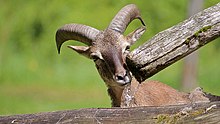Ferleiten wildlife and adventure park
| Ferleiten wildlife and adventure park | |
|---|---|
| place | Taxenbacher Fusch 96 5672 Ferleiten |
| surface | 35 hectares |
| opening | 1980 |
| Animal species | about 40 species |
| Individuals | over 200 animals |
| Visitor numbers | approx. 80,000 (2017) |
| organization | |
| management | Georg Mayr-Reisch |
| Ferleiten wildlife and adventure park | |
Coordinates: 47 ° 10 ′ 7.8 " N , 12 ° 48 ′ 50.3" E
The Ferleiten Wildlife and Adventure Park is located at the foot of the Grossglockner High Alpine Road , in the Austrian state of Salzburg. Ferleiten belongs to the municipality of Fusch on the Großglocknerstrasse , located in Pinzgau. The adventure park extends over an area of 20 hectares and offers over 40 adventure play options. The wildlife park is 15 hectares and is home to over 200 animals from around 40 animal species.
history
One tried to explain the name Ferleiten in different ways. The name "Verlatten" was first used as a term for Sennhütte (Schwaige) as early as 1272. Ferleiten was a double-tailed woman who was very princely and had to make 600 small cheeses a year. Another attempt to clarify the term was made in a travel book by Reichl, Berlin 1845. Ferleiten was interpreted as “the dangerous ladder”. The actual meaning comes from the wording "bells", since in earlier times the bell was rung for Tauern hikers in fog and noises were made to make orientation easier for hikers.
Until 1900 only one alpine path led to Ferleiten. In 1903 a road was built that could handle small amounts of traffic. It was only developed into a high-performance mountain road in the years 1931 to 1935 when the Großglocknerstrasse was built.
Since the agriculture with a size of 15 hectares was not particularly productive, a rededication into a wildlife park was considered. In the autumn of 1979, the routing and construction of the first enclosures for red deer, fallow deer, ibex and mouflon began. The first pond system was also created and stocked with local ducks and fish. From then on, the facility was expanded annually with new enclosures and aviaries. Today over 200 animals and 40 different species live in the Ferleiten Wildlife Park. According to the EU regulation, the wildlife park is a category B zoo and approved as such.
In 2010 the idea of the national park to build a house for fish in the wildlife park was realized. In August 2011 the exhibition “Life under water” was opened by State Councilor Tina Widmann after a year of construction . The content of the exhibition is life in flowing and still waters of the high mountains. In addition to interactive exhibits and a cinema, the glass mountain lake and the mountain stream aquariums with live fish take visitors under the surface of the water and provide information about this high mountain habitat.
Numerous investments have also made it possible to build an amusement park from an initially small children's playground, which is constantly being expanded.
The Lukashansl inn was built in 1874 by the Bruck innkeeper Johann Mayr. Known and famous around 1900 was the "Schwarze Marie", a housekeeper who achieved amazing things through her circumspection and agility and was therefore always a good pillar of the business at the Lukashansl inn. The inn used to have 40 rooms with 70 beds as well as a dining room with an adjoining glass veranda and a reading room. The King of Bulgaria and Hugo von Hofmannsthal also visited Ferleiten annually.
In 1980 the old inn was closed and in the same year the Wildpark-Alm, which still exists today, was opened. On January 1, 1987, Georg Mayr-Reisch took over the business from Elfriede Mayr.
Individual evidence
- ↑ High tourism award for a leading company in Fuscher. on fusch.at , accessed on January 6, 2018.
- ↑ a b c Josef Lahnsteiner: Mitterpinzgau. Saalbach, Saalfelden, Lofer, Salzburg Saaletal. Hollersbach 1980.
- ^ National park exhibition: Life under water. at nationalpark.at , accessed on January 6, 2018




